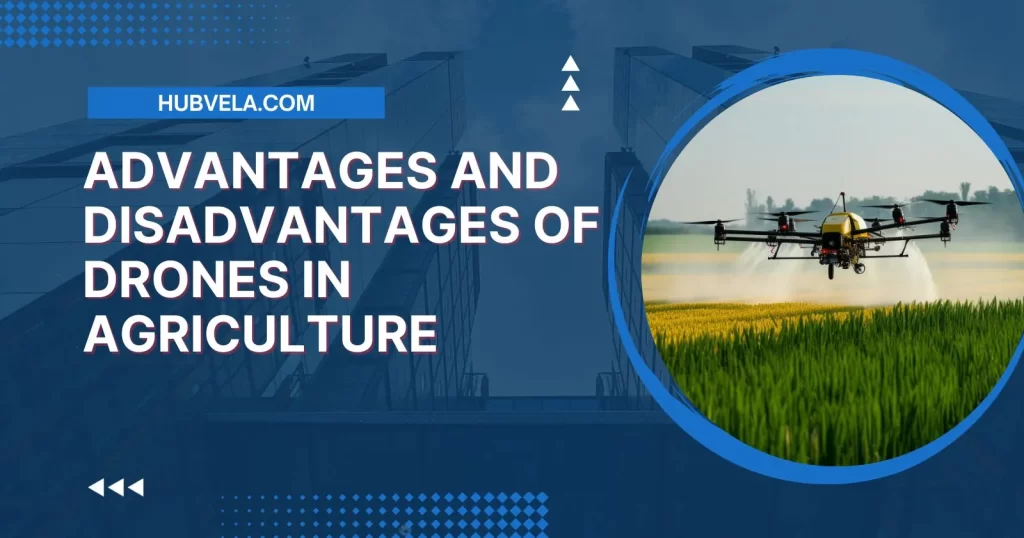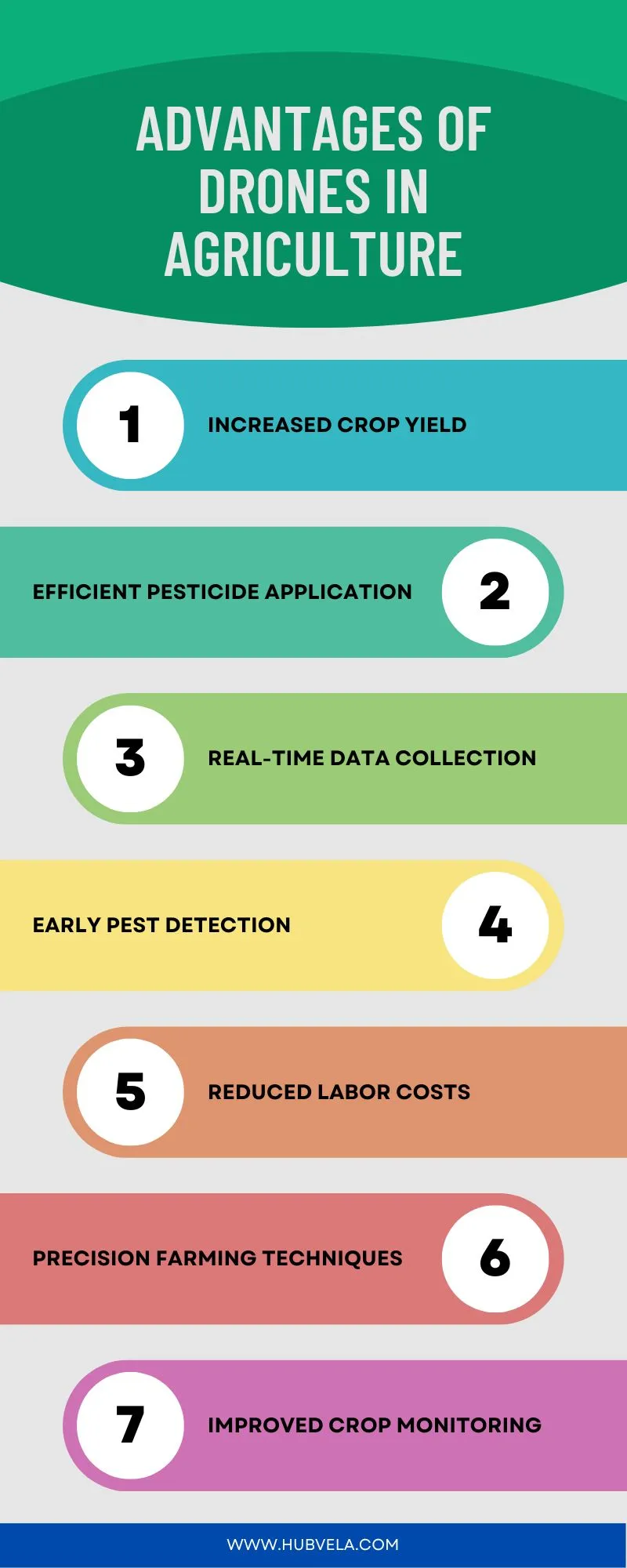As you stroll through the lush fields of modern agriculture, you can’t help but notice the buzzing sound overhead. It’s a coincidence that drones have become an integral part of the agricultural landscape. These unmanned aerial vehicles offer a range of advantages that can significantly enhance farming practices.
From increasing crop yield to efficient pesticide application, drones are revolutionizing the way farmers approach their craft. However, like any technological advancement, there are also disadvantages to consider.
From privacy concerns to vulnerability to weather conditions, the advantages and disadvantages of drones in agriculture are worth exploring further. So, let’s uncover the potential benefits and drawbacks of these high-flying machines and how they impact the future of farming.

--Advertisement--
Advantages of Drones in Agriculture
Drones offer various advantages in agriculture, revolutionizing the industry. Some of the key benefits include:

1. Increased Crop Yield
By using drones in agriculture, you can significantly increase your crop yield. Drones offer increased efficiency through automation and data analysis. With the help of advanced technology, drones can collect valuable data about soil conditions, crop health, and irrigation needs.
This information allows farmers to make informed decisions and optimize their farming practices. By minimizing environmental impact and maximizing productivity, drones play a crucial role in improving crop yield and ensuring sustainable agriculture.
2. Efficient Pesticide Application
With their ability to precisely apply pesticides, drones revolutionize the efficiency of pesticide application in agriculture.
Through precision spraying, drones can target specific areas of crops, resulting in reduced pesticide waste and improved crop health.
Drones equipped with remote sensing technology can identify areas of the field that require treatment, optimizing pesticide application.
With autonomous navigation, drones can navigate through crops without damaging them.
This not only saves time and labor but also minimizes the environmental impact of pesticide use.
3. Real-Time Data Collection
To further enhance the efficiency of agricultural practices, drones offer the advantage of real-time data collection, allowing farmers to make informed decisions based on up-to-date information.
Drones equipped with advanced sensors and cameras can provide real-time monitoring of crop health, allowing for quick and accurate crop assessment. This data can then be analyzed to optimize the allocation of resources such as water, fertilizers, and pesticides, leading to improved resource optimization.
Additionally, real-time data collection can aid in yield prediction, enabling farmers to plan and manage their harvest more effectively.
4. Early Pest Detection
Drones in agriculture provide the advantage of early pest detection, allowing farmers to quickly identify and address potential threats to their crops. Through remote sensing technology, drones can monitor vast areas of farmland, detecting signs of pest infestation before crop damage occurs.
This early warning system enables farmers to implement effective pest management strategies, minimizing crop losses and maximizing yields. By integrating drones into precision agriculture practices, farmers can proactively protect their crops and improve overall productivity.
5. Reduced Labor Costs
One of the advantages of incorporating drones into agriculture is the potential for reduced labor costs. Drones offer increased efficiency in tasks such as crop health monitoring, saving time and reducing the need for manual labor.
By using this time-saving technology, farmers can allocate their resources more effectively.
Drones also provide accurate data, allowing farmers to make informed decisions about their crops.
6. Precision Farming Techniques
Using drones in agriculture provides farmers with advanced precision farming techniques, revolutionizing the way crops are monitored and managed.
Through remote sensing and data analysis, drones enable precise monitoring of crop health, identifying areas of concern and allowing for targeted treatment.
This real-time data helps farmers optimize yields by making informed decisions about irrigation, fertilization, and pest control.
Drones enhance efficiency and accuracy in agriculture, empowering farmers to maximize productivity and minimize environmental impact.
7. Improved Crop Monitoring
With advanced precision farming techniques, you can now benefit from improved crop monitoring through the use of drones.
Drones equipped with remote sensing technology enable accurate crop analysis, allowing you to gather real-time data on plant health, disease detection, and soil fertility.
By identifying problem areas and monitoring irrigation management, you can make informed decisions to optimize crop production.
Drones offer a cost-effective and efficient solution for enhancing your crop monitoring capabilities.
Disadvantages of Drones in Agriculture
Drones have become increasingly popular in agriculture, offering benefits such as precision mapping, crop spraying, and monitoring.
However, there are several disadvantages to their use. Some of the potential risks and limitations associated with using drones in agriculture include

1. Limited Flight Time
Drones in agriculture face a significant disadvantage due to their limited flight time. The flight duration of drones is determined by their battery life and power limitations. This restricts their flight range and the amount of time they can spend collecting data or performing tasks.
Additionally, recharging time can be lengthy, further reducing the efficiency and productivity of drones in agricultural operations. The limited flight time of drones hinders their ability to cover large areas and perform prolonged tasks in the field.
2. Regulatory Restrictions
One major drawback of using drones in agriculture is the presence of regulatory restrictions that limit their full potential.
Agricultural drone operators face various regulatory challenges, including airspace restrictions, legal limitations, and licensing requirements. These restrictions can hinder the widespread adoption of drones in agriculture and limit their effectiveness in improving farming practices.
Additionally, compliance issues surrounding privacy and safety regulations further complicate the use of drones in this industry.
As a result, farmers and drone operators must navigate these regulatory hurdles to fully harness the benefits of agricultural drones.
3. High Initial Cost
As you explore the disadvantages of drones in agriculture, a significant drawback to consider is the high initial cost associated with their implementation. While technological advancements have made drones more efficient and capable, they still come with a hefty price tag.
This can impact the cost effectiveness and return on investment for farmers, especially smaller ones. Additionally, the long term benefits of using drones in agriculture may take time to materialize, making it difficult to justify the high initial cost.
Moreover, market competition can drive up the prices of drones, further hindering their affordability for farmers.
4. Skill and Training Required
Learning to operate drones in agriculture requires specialized skills and training. To effectively operate a drone in agricultural settings, you must possess the necessary technical skills and knowledge of piloting techniques.
Additionally, you need to be well-versed in safety protocols to ensure the well-being of both the drone and those around it.
Furthermore, obtaining the required licenses is crucial, as it ensures compliance with regulations and legal requirements in the licensing process.
5. Privacy Concerns
To fully understand the disadvantages of drones in agriculture, it’s important to consider the privacy concerns that arise with their use.
Privacy concerns encompass legal implications, ethical considerations, data security, and public perception. The use of drones in agriculture raises questions about the invasion of privacy, as they can capture images and data without consent.
This can lead to potential legal issues and damage public trust. Ensuring data security and addressing public concerns are crucial for the responsible use of drones in agriculture.
6. Vulnerability to Weather
Drones in agriculture can be highly vulnerable to weather conditions, which poses a significant disadvantage in their use. Weather vulnerability can lead to crop damage and equipment failure, making it difficult for drones to effectively operate in adverse conditions.
Additionally, weather conditions can impact the accuracy of data collected by drones, affecting the reliability of the information obtained.
Furthermore, flight restrictions may be imposed due to inclement weather, further limiting the effectiveness of drones in agricultural operations.
7. Limited Payload Capacity
One significant disadvantage of utilizing drones in agriculture is their limited payload capacity. This can pose challenges when it comes to carrying heavy equipment or payloads necessary for certain agricultural tasks. For example, drones with payload limitations may struggle to carry advanced sensors for accurate crop analysis or planting automation systems.
Additionally, limited payload capacity may restrict the use of remote sensing technologies, impacting the overall data accuracy and efficiency of agricultural operations.
Conclusion on Advantages and Disadvantages of Drones in Agriculture
Drones offer numerous advantages in agriculture, including increased crop yield, efficient pesticide application, and real-time data collection. They enable precision farming techniques, reduce labor costs, and improve crop monitoring.
However, there are also disadvantages, such as limited flight time, regulatory restrictions, high initial cost, and privacy concerns.
Farmers must carefully consider these factors before implementing drone technology in their agricultural operations.


